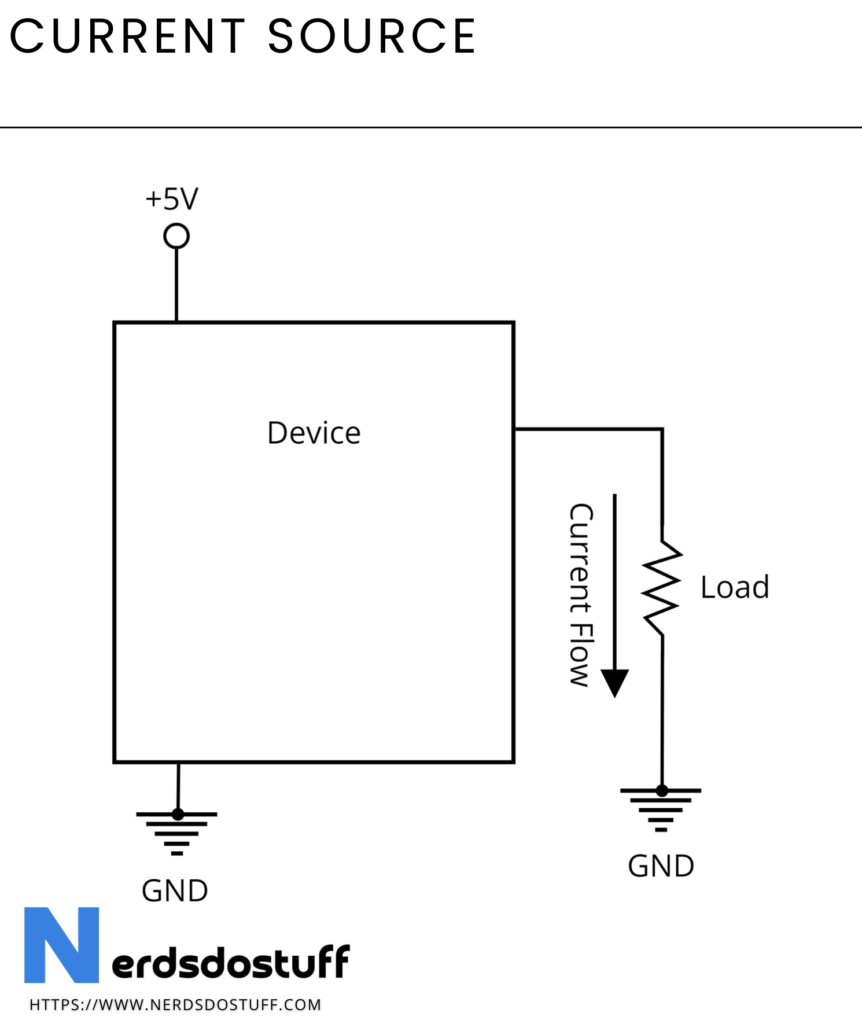What is Current Source?
A current source is a circuit or device designed to provide a consistent and controlled amount of electrical current to a connected load. In contrast to a current sink, which absorbs or sinks current, a current source actively supplies current to the circuit. The primary goal of a current source is to maintain a stable current flow through the load, regardless of changes in other circuit parameters such as voltage or resistance.
A common analogy for a current source is a device that acts like a pump for electric current, pushing a specific amount of charge through the circuit. The key characteristic of a current source is its ability to deliver a constant current, making it valuable in applications where a reliable and precisely controlled current is essential for proper functioning. Current sources are frequently used in electronics for biasing transistors, powering sensors, and providing a stable reference current in various precision applications. The implementation of current sources can involve different circuit configurations, including the use of transistors or specialized integrated circuits designed for this purpose.
Current Source Circuit Diagram

A current source circuit is designed to generate a consistent and controlled flow of electrical current through a connected load. The key objective is to maintain a stable current regardless of changes in other circuit parameters. The circuit is typically built around a specific component, often a transistor such as a bipolar junction transistor (BJT) or a field-effect transistor (FET), depending on the application requirements.
Circuit Explanation:
- +5V Connected to Device: The positive terminal of a 5-volt power supply (+5V) is connected to your device. This provides the necessary voltage for the device to operate.
- GND Connected to Device: The ground (GND) is connected to your device, serving as the reference point for the circuit’s voltage levels.
- GND Connected to Load: On the right-hand side of the circuit, the ground (GND) is connected to the load. This establishes the ground reference for the load.
- Load Connected to Device: The load is connected to the device, forming a circuit loop. Current flows from the device towards the ground (GND) through the load, indicating that the device is acting as a current sink by drawing current towards the ground.
Working of Current Source Circuit
A current source is a circuit configuration designed to provide a controlled and stable amount of electrical current to a connected load. In contrast to a current sink, which absorbs or sinks current, a current source actively supplies current to the circuit. The central component in a current source circuit is often a transistor, with the type depending on the specific application—common choices include bipolar junction transistors (BJTs) or field-effect transistors (FETs).
The operation of a current source involves controlling the transistor’s characteristics to establish a constant current flow through the connected load. The input signal, typically applied to the base of a BJT or the gate of an FET, regulates the transistor’s conductivity. Unlike in a current sink, where the emitter (for BJT) or source (for FET) is connected to the ground, in a current source, this terminal is often connected to a specific voltage level, creating a reference potential.
A load resistor is still present in a current source circuit, typically connected between the power supply voltage and the collector (for BJT) or drain (for FET). However, the key distinction lies in the fact that the current source actively supplies a predetermined current through this load resistor, maintaining a stable and controlled current flow.
Adjusting the input signal or modifying the biasing of the transistor allows for the regulation of the current provided by the current source. This level of control is crucial in applications where a consistent and precisely controlled current is required, such as in precision instrumentation, sensor interfaces, or biasing circuits. Current source circuits play a fundamental role in ensuring reliable and predictable current delivery to meet the demands of various electronic systems.
Applications of Current Source
- Transistor Biasing:
- Current source circuits are frequently used in transistor biasing networks to establish a consistent and controlled current flow through the base or gate of a transistor. This is crucial for maintaining the transistor in its active region, ensuring reliable and linear amplification in applications like audio amplifiers and RF circuits.
- Sensor Interface:
- Current source circuits are employed in sensor interfaces, especially in applications where sensors exhibit resistance changes. By providing a constant current through the sensor, variations in voltage can be directly proportional to changes in resistance. This is commonly seen in resistance temperature detectors (RTDs), strain gauges, and other sensors used in measurement and control systems.
- Precision Instrumentation:
- In precision instrumentation, where accurate and stable current is required, current source circuits play a significant role. Devices such as digital-to-analog converters (DACs) or operational amplifiers (op-amps) often utilize current sources to generate precise currents for calibration, signal generation, or as a reference in measurement equipment.
- Voltage Regulator Current Source:
- Current source circuits can be integrated into voltage regulator designs to provide a stable bias current. This is commonly seen in voltage regulator circuits where a reference current is required for regulating the output voltage. The use of a current source ensures a consistent and well-controlled current, contributing to the overall stability of the voltage regulation.




